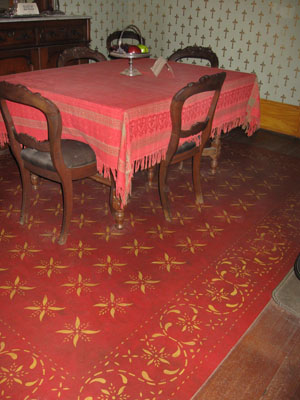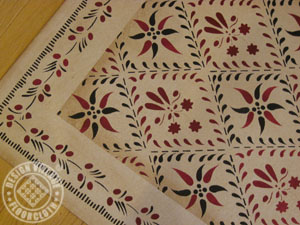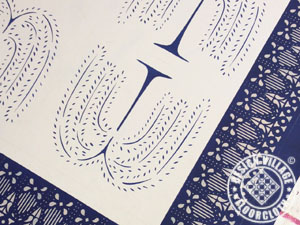Construction of our Floorcloths
We take pride in making high quality long lasting floorcloths. After years of tests and trials on different weight canvas fabrics using several types of primers, paints, varnishes, polyurethane's and glues we perfected the art of making museum quality floorcloths.
Our best testimonial comes from the Whaley House Museum, San Diego, CA where since 2005 over one hundred thousand visitors walk on the floorcloth every year.
Canvas for Floorcloth
We use extra heavy duty double fill artist quality cotton canvas. This heavyweight canvas works very well for floorcloths and lays flat on the floor.
Note: All Design Village Floorcloths are primed on both sides. Some floorcloth makers do not prime the back which may cause following issues. During summer months when humidity is high, moisture can be trapped under the floorcloth and the unprimed side may buckle. Also, if water goes under the floorcloth, the paint on the top may peel, staining the floorcloth from the top and warping the canvas beyond repair.
We do not use a sticky skid resistant coating on our floorcloths, because it picks up unwanted dirt, sand, and pet hair, gets tacky when wet, and is not removable. We do suggest using a very thin flat rug gripper.

Primer for Floorcloths
After stretching the canvas we use Acrylic gesso to prime, which is recommended for paintings and flexible surfaces. The flexibility prevents the floorcloths from cracking with age. Design Village Floorcloths are double primed on the top surface and also primed with a water resistant layer on the back to improve durability.
Acrylic Gesso is not the same as the traditional gesso formula of white pigment and chalk mixed with hide glue. Although both are designed to create a primed surface for painting, the traditional gesso can only be used on a rigid support, such as a wood panel, since it is not flexible and will crack if applied to anything that moves or bends.
 Commonly used primers are created for hard surfaces such as walls, wood, etc. Such primers will keep the cost down but will shorten the life of a floorcloth.
Commonly used primers are created for hard surfaces such as walls, wood, etc. Such primers will keep the cost down but will shorten the life of a floorcloth.
Background color of the floorcloths
We use two or three coats of fade resistant paint which is made for flexible surfaces. This prevents the paint from cracking and improves the durability. To decorate the floorcloths we use stencils, stamps, sponges and other tools. Some of our stencils are unique and are hand-cut in our studio.
All products we use for our floorcloths are water-based and non-toxic.

Floorcloth Top Coat
To protect the painted finish we use multiple coats of our custom blend protective coating. It is permanent, non-yellowing, flexible, and water-resistant. It will not crack as the surface expands or contracts during temperature and humidity changes.
Some floorcloth makers use polyurethane. This cheap protector is designed to harden with age and tend to become brittle. Therefore it is not advisable for flexible surface like a floorcloth.
Floorcloth Edges
Our floorcloths have a two inch mitered hem. This helps to keep the floorcloth flat and prevents the edges from fraying and curling. This gives the floorcloth a flat, finished look.
We do not use bowling alley wax on our floorcloths. Commonly used on cheaper floorcloths, bowling alley wax makes floorcloth slippery and may not provide the best protection.
Please view our floorcloth preview gallery to see how floorcloths are made.








